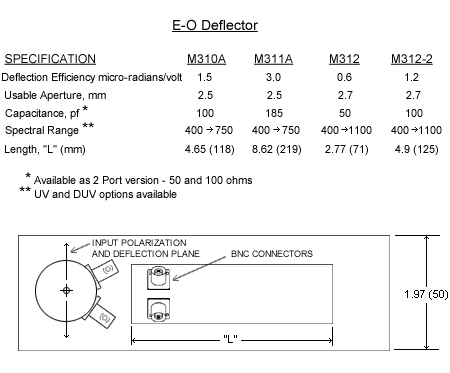Description
Conoptics series of electro-optic beam deflectors utilize a quadrapole electric field in an electro-optic material to produce a linear refractive index gradient proportional to the applied signal voltage. Choice of the proper material and crystallographic orientation eliminates piezoelectric ringing normally associated with other deflectors. There are no moving parts and they do not fatigue with prolonged use.
The angular deflection of E-O Deflectors is small but has rapid random access response and is extremely precise. Major applications include facet to facet error correction in laser data and image recorders which use spinning mirrors and the generation and stabilization of auxilary tracks in optical disk mastering machines. Unlike acousto-optic deflectors, the intrinsic random access response of an electro-optic deflector is the optical rather than acoustic transit time. In practice, however, E-O Deflectors appear as capacitive loads and the response is driver limited. The precision with which a laser beam can be located, for all intents and purposes, is equivalent to the precision with which a voltage level can be applied to the device. Since operation is based on an index gradient, variations due to ambient temperature changes are reduced to second order effects. Similarly, unlike acousto-optic deflectors in which the deflection angle is proportional to the optical wavelength, the deflection angle of an electo-optic deflector is a function of the index dispersion and is relatively constant over the wavelength range of operation.
Other advantages of an E-O Deflector over an acousto-optic device include the fact that the entire beam is deflected. The transmission efficiency is limited only by the Fresnel reflections, absorbtion, and scattering losses in the cell and is not a funtion of the deflection mechanism.
Furthermore, E-O Deflectors are "straight through" devices, that is, the beam is deflected about the undeflected zero applied signal position. This is in contrast to acousto-optic devices which have a large angular offset to the center of the deflection range and require that RF be maintained on the cell when the beam is in the quiescent position.









































